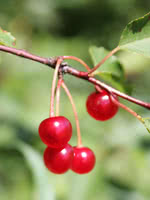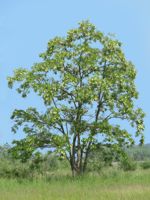Mon-Fri 9am - 5pm Mountain time
Pin Cherry vs Black Locust
Prunus pensylvanica
Robinia pseudoacacia
NOT AVAILABLE THIS SEASON - MIGHT RETURN
Pin Cherry is a small tree that produces clusters of white blossoms in spring followed by bright red berries that ripen through the summer. The attractive red color of the leaves in the fall is an added bonus.
The fruit is quite sour when eaten fresh but is excellent when cooked into jam or jelly. Birds love the berries and will be attracted to your property.
Black Locust is an attractive tree. Its distinctive leaves are made of about a dozen bright green leaflets. It also notable for its fragrant white flowers, which smell of citrus.
Black Locust can grow in many situations, but prefers dry areas with lots of sun. It is robust and is an excellent choice for establishing shade in dry, open areas.
Important note: Much of the Black Locust is toxic to humans and livestock, including seeds, bark, and leaves.

